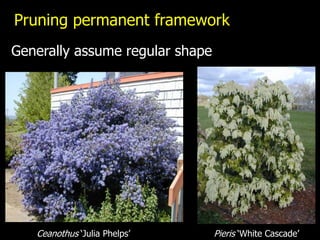
Pruning Shrubs part2
- 1. Pruning permanent framework Generally assume regular shape Ceanothus „Julia Phelps‟ Pieris „White Cascade‟
- 2. Many of these plants form a dome-shaped canopy
- 3. Remove: • dead • damaged Cistus „Silver Pink‟
- 5. Removal of errant shoots help shape
- 8. “Cubist” pruning is common…
- 10. Or, the meatball variation…
- 11. Think about flowering time before pruning!
- 14. Shearing removes form, but hopefully not flowers… Arbutus unedo (Strawberry tree)
- 15. Pruning subshrubs have woody base, but bloom on current season‟s shoots some become larger and more woody in mild climates avoid pruning until after risk of severe freeze Buddleia nivea
- 16. Small subshrubs which may be sheared: Epilobium canum Penstemon pinifolius
- 17. Remove most shoot growth to base August 2010 January 2011
- 18. Before… After…
- 19. Larger subshrubs… Caryopteris x clandonensis Perovskia atriplicifolia
- 20. Spiraea
- 21. Large subshrubs Buddleia „Pink Delight‟ Heptacodium miconioides
- 22. Remove dead stems, prune hard in spring Lavatera: early spring 10 minutes work!
- 23. Note where cuts made… Look how much growth is removed!
- 24. Later…
- 26. Suckering shrubs Naturally thicket-forming plants Includes: • Aralia spp. • Clerodendrum spp. • Kerria japonica • Rhus spp. • Rubus spp. • Symphoricarpos spp. • Syringa vulgaris • Zenobia pulverulenta Dig suckers Rhus typhina „Laciniata‟ Use barriers
- 27. Pruning Conifers For pruning purposes, there are two types: Needle-like leaves Scale-like foliage Whorled branches Random branches
- 28. Needle-foliage Conifers: Pine Family Abies: The Firs Cedrus: True Cedars Picea: The Spruces Pinus: The Pines Pseudotsuga: Douglasfir Tsuga: The Hemlocks
- 29. When sited correctly, rarely need pruning Abies pinsapo „Glauca‟ Pinus thunbergii „Thunderhead‟
- 30. The biggest mistake: pruning into un-needled growth
- 31. Pine Family To dwarf plant and fill in canopy, pinch back new growth at “candle” stage Do not cut into old, un-needled parts of stem!
- 33. Candles on pines are easily broken at this stage
- 34. Candle pruning makes a conifer… dwarfer bushier
- 35. Some conifers revert as well… Alberta spruce
- 36. Scale-foliage Conifers: Cypress Family Calocedrus Incense Cedar Chamecyparis Hinoki Cypress Cupressus Monterey, Italian Cypress X Cupressocyparis leylandii Leyland Cypress Juniperus many, many species/forms Thuja Arborvitae, Western Redcedar
- 37. Cypress family plants respond well to light trimming and make good hedges Don‟t prune into older un-needled parts of plant!
- 38. Effects of hard pruning: Cutting back hedge Limbing up too-big shrub
- 41. Conifers that respond to cutting to older wood: Taxus: Yews Sequoia: Redwood Cryptomeria: Japanese cedar
- 42. Pruning Vines
- 43. Pruning need depends on vigor, climbing habit… Wisteria Jasminum x stephanense rampant growing many thin canes permanent framework cane-grower
- 44. Consider the climbing habit of the plant: Non-clinging plants: Roses
- 45. Twining growth habit: Clematis Jasminum Humulus Trachelospermum Lonicera Wisteria Tendrils: Ampelopsis Passiflora Vitis
- 46. Clinging vines Campsis (aerial rootlets) (will also sucker) Hydrangea anomala (aerial rootlets) Hedera (aerial rootlets) Parthenocissus (tendrils) Schizophragma (aerial rootlets) Little or no pruning required
- 47. The support structure and vine must match!
- 48. Climbing roses
- 49. A trellis can be very simple…
- 50. Old trees make a good makeshift trellis, too
- 51. Climbers-modern: very tall bush roses, repeat renew framework regularly Rambling Roses annual cane production train stems flat remove flowered stems thin/shorten excess canes
- 52. Climbing roses Spreading out stems horizontally encourages branching
- 53. Climbing Rose: „Westerland‟ Modern Climber i.e. blooms on new wood
- 54. Early spring…
- 55. Later…
- 56. Rambling Rose „Dorothy Perkins‟ Once-blooming June 2004
- 57. Sept. 2004 July 2005
- 58. July 2006
- 60. For a full arbor you will need to plant on both sides
- 62. Twining vines Clematis armandii
- 63. As with other vines, match the vine with available space
- 64. Over time, many twining climbers form a “mushroom” Jasminum x stephanense
- 65. Or, the shape of a TV antenna…
- 66. Young vines: shoot placement
- 67. Lonicera japonica In bloom, June After pruning
- 68. Pruning vining Clematis For pruning purposes, 3 “groups” based on flowering time: Spring: (Group 1) C. armandii, C. montana Repeat bloom: (Group 2) Large-flowered hybrids C. „Nelly Moser‟ Summer-Fall: (Group 3) C. x jackmanii, C. texensis C. paniculata, C. viticella
- 71. Pruning Clematis-Group 1 and 2
- 72. Pruning vines: Clematis Group 2 (and 1) Remove weak growths Thin stems to well—spaced framework
- 74. Pruning Clematis Group 3 Prune low to a pair of strong buds early spring Remove dead stems
- 76. Trees make handy trellises…
- 78. Brickell and Joyce DK Publishing, 1996 ISBN 1-56458-331-7
- 79. Brown and Kirkham Timber Press, 2004 ISBN 0-88192-613-2
- 80. Cass Turnbull Sasquatch Books ISBN 1570613168
- 81. Other references: PlantAmnesty http://www.plantamnesty.org/ Pruning tips PNW-International Society of Arboriculture http://www.pnwisa.org/ Pruning information Publications Lists of Consulting Arborists
- 83. The End! Ceanothus griseus „Kurt Zadnik‟
